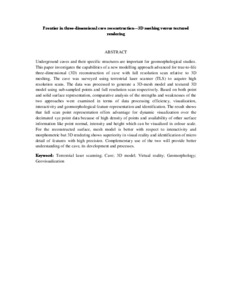Citation
Idrees, Mohammed Oludare and Pradhan, Biswajeet
(2017)
Frontier in three-dimensional cave reconstruction—3D meshing versus textured rendering.
In: Global Civil Engineering Conference (GCEC 2017), 25-28 July 2017, Kuala Lumpur, Malaysia. (pp. 1029-1038).
Abstract
Underground caves and their specific structures are important for geomorphological studies. This paper investigates the capabilities of a new modelling approach advanced for true-to-life three-dimensional (3D) reconstruction of cave with full resolution scan relative to 3D meshing. The cave was surveyed using terrestrial laser scanner (TLS) to acquire high resolution scans. The data was processed to generate a 3D-mesh model and textured 3D model using sub-sampled points and full resolution scan respectively. Based on both point and solid surface representation, comparative analysis of the strengths and weaknesses of the two approaches were examined in terms of data processing efficiency, visualization, interactivity and geomorphological feature representation and identification. The result shows that full scan point representation offers advantage for dynamic visualization over the decimated xyz point data because of high density of points and availability of other surface information like point normal, intensity and height which can be visualized in colour scale. For the reconstructed surface, mesh model is better with respect to interactivity and morphometric but 3D rendering shows superiority in visual reality and identification of micro detail of features with high precision. Complementary use of the two will provide better understanding of the cave, its development and processes.
Download File
![[img]](http://psasir.upm.edu.my/64624/1.hassmallThumbnailVersion/Frontier%20in%20three-dimensional%20cave%20reconstruction%E2%80%943D%20meshing%20versus%20textured%20rendering.pdf)  Preview |
|
Text (Abstract)
Frontier in three-dimensional cave reconstruction—3D meshing versus textured rendering.pdf
Download (50kB)
| Preview
|
|
Additional Metadata
Actions (login required)
 |
View Item |

